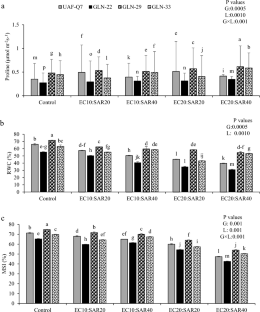Journal of Plant Growth Regulation ( IF 4.8 ) Pub Date : 2024-04-23 , DOI: 10.1007/s00344-024-11315-w Asma Zafar , Ghulam Murtaza , Irfan Afzal , Zia Ur Rahman Farooqi , Weibo Shen , Ali Raza

|
Salinization and sodication present significant threats to crop productivity in many parts of the world including Pakistan. Cultivating halophytes like quinoa presents a viable solution for the profitable use of salt-affected lands. This study specifically examines the performance and salt tolerance mechanism of four quinoa accessions under varying salinity and sodicity levels. In addition to a control group, different combinations of electrical conductivity and sodium adsorption ratio (ECe dS m−1 SAR levels) were established: 10:20, 10:40, 20:20, and 20:40, achieved by using a mixture of salts. Most of the quinoa cultivars exhibited robust growth, with the exception of GLN-22, which proved unable to withstand high levels of salinity and sodicity, resulting in a 78% reduction in yield. GLN-29, on the other hand, demonstrated superior performance across all levels of salinity and sodicity. UAF-Q7 excelled under conditions of high salinity and low sodicity compared to equivalent salinity levels but elevated sodicity. Meanwhile, GLN-33 exhibited enhanced growth under elevated sodicity levels but struggled in the face of high salinity stress. In terms of nutrient uptake, GLN-29 displayed a higher accumulation of Na+ (32%) in older leaves compared to younger ones, alongside elevated levels of antioxidant activity at all salinity and sodicity levels. Notably, GLN-29 exhibited excellent adaptation to both high salinity and sodicity levels, resulting in the highest grain yield (14.75 g/pot) and the salt tolerance mechanism was associated with highly efficient K+ retention and transport of Na+ to older leaves. This underscores the necessity for further comprehensive field studies to ascertain its suitability for the sustainable utilization of salt-affected soils.
中文翻译:

不同盐度和碱度水平下四个藜麦品种耐盐性生理生化机制的比较
盐碱化和碱化对包括巴基斯坦在内的世界许多地区的作物生产力构成重大威胁。种植藜麦等盐生植物为受盐影响土地的盈利利用提供了可行的解决方案。本研究专门研究了四种藜麦品种在不同盐度和碱度水平下的性能和耐盐机制。除对照组外,还建立了电导率和钠吸附比(ECe dS m −1 SAR 水平)的不同组合:10:20、10:40、20:20 和 20:40,通过使用混合物实现盐。大多数藜麦品种都表现出强劲的生长,但 GLN-22 除外,该品种被证明无法承受高水平的盐度和碱度,导致产量下降 78%。另一方面,GLN-29 在各个盐度和碱度水平上都表现出了卓越的性能。与同等盐度水平但高钠度的条件相比,UAF-Q7 在高盐度和低钠度条件下表现出色。与此同时,GLN-33 在较高的碱度水平下表现出增强的生长,但在高盐度胁迫下却表现得举步维艰。在养分吸收方面,与年轻叶片相比,GLN-29 在老叶片中积累了更高的 Na + (32%),同时在所有盐度和碱度水平下的抗氧化活性水平都较高。值得注意的是,GLN-29 对高盐度和碱度水平表现出优异的适应能力,从而获得最高的谷物产量(14.75 克/盆),并且耐盐机制与高效的 K +保留和 Na +向老叶的运输有关。这强调了进一步全面实地研究的必要性,以确定其是否适合可持续利用受盐影响的土壤。



























 京公网安备 11010802027423号
京公网安备 11010802027423号